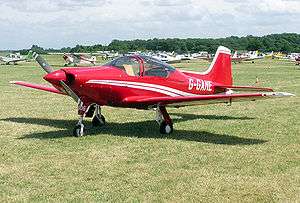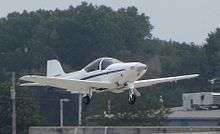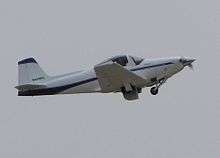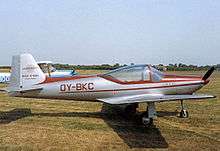Sequoia Falco
The Sequoia Falco is an Italian-designed lightweight 2-seater aerobatic aircraft.[2]
| Sequoia Falco F8L | |
|---|---|
 | |
| 1993 Sequoia Falco F8L | |
| Role | Homebuilt aircraft |
| National origin | Italy |
| Manufacturer | Sequoia Aircraft Company |
| Designer | Stelio Frati |
| First flight | 1955 |
| Status | Production completed (2014) |
| Number built | 90 (2011)[1] |
| Unit cost |
US$70,000 (kit, 1998)[2] |
| Variants | Sequoia 300, Sequoia 300, Sequoia Kodiak |


Design and development
The aircraft was designed by the renowned Italian designer Stelio Frati[3] in 1955, and originally built in Italy by Aviamilano then Aeromere and later Laverda.
The aircraft is single-engined, propeller driven and designed for private and general aviation use.[1][3] The Falco was sold in kit or plans form for amateur construction by the Sequoia Aircraft Company of Richmond, Virginia until its closure in 2014.[4]

The design was adopted in the US in the 1980s and converted to kit form. The aircraft is widely considered to be one of the best handling, strongest, and most aesthetically pleasing designs ever made available to home builders.[3]
Performance includes a 175 knot cruise speed and 6g aerobatic capability.[3]
The Sequoia Falco F8L is constructed of spruce and typically Finnish birch plywood. The structure is built from laminated spruce bulkheads and the birch plywood is used for the skin.[5] The plywood is often softened with hot steam, formed over the various structures and glued in place. The aircraft is rated for 6g positive and 3g negative.
Reviewers Roy Beisswenger and Marino Boric described the design in a 2015 review as "a complex all-wooden construction in spruce and plywood and is therefore time-consuming to build. But the results in terms of weight and speed are remarkable., so much so that the Falco is considered a classic, with outstanding performance and handling."[6]
Variants
- F.8L Series I
- Initial production model powered by 101 kW (135 hp) Lycoming engine. Ten built by Aviamilano.[7]
- F.8L Series II
- Improved model built by Aviamilano, with 112 kW (150 hp) engine.[7] Twenty built.[8]
- F.8L America
- Modified version of Series II built by Aeromere in conformance with US airworthiness requirements.[7]
- Super Falco Series IV
- Similar to America, but with more powerful engine and constant speed propeller. Built by Laverda.[7]
- Sequoia Falco
- Similar to the production aircraft but re-designed for homebuilding from kits or plans, by Alfred Scott of Sequoia Aircraft Company and David Thurston of Lake Buccaneer fame.
Specifications (Laverda Super Falco Series IV)
Data from Jane's All The World's Aircraft 1965-66 [9]
General characteristics
- Crew: one
- Capacity: one passenger
- Length: 6.50 m (21 ft 4 in)
- Wingspan: 8.00 m (26 ft 3 in)
- Height: 2.27 m (7 ft 5 in)
- Wing area: 10.0 m2 (108 sq ft)
- Aspect ratio: 6.4:1
- Airfoil: NACA 64213
- Empty weight: 550 kg (1,213 lb)
- Max takeoff weight: 820 kg (1,808 lb)
- Fuel capacity: 120 L (32 US gal; 26 imp gal)
- Powerplant: 1 × Lycoming O-320-B1A air-cooled flat-four engine, 120 kW (160 hp)
- Propellers: 2-bladed Hartzell fixed-pitch propeller, 1.75 m (5 ft 9 in) diameter
Performance
- Maximum speed: 325 km/h (202 mph, 175 kn) at sea level
- Cruise speed: 250 km/h (160 mph, 130 kn) (econ. cruise)
- Stall speed: 98 km/h (61 mph, 53 kn) (30% flaps)
- Never exceed speed: 385 km/h (239 mph, 208 kn)
- Range: 1,400 km (870 mi, 760 nmi)
- Service ceiling: 6,000 m (19,700 ft)
- Rate of climb: 5.00 m/s (984 ft/min)
See also
- Aermacchi SF.260 (military trainer designed by Frati)
- PAC CT/4 (Pacific Aerospace Limited)
Notes
- Vandermeullen, Richard: 2011 Kit Aircraft Buyer's Guide, Kitplanes, Volume 28, Number 12, December 2011, page 69. Belvoir Publications. ISSN 0891-1851
- Purdy, Don: AeroCrafter - Homebuilt Aircraft Sourcebook, Fifth Edition, page 251. BAI Communications, 15 July 1998. ISBN 0-9636409-4-1
- Bayerl, Robby; Martin Berkemeier; et al: World Directory of Leisure Aviation 2011-12, page 118. WDLA UK, Lancaster UK, 2011. ISSN 1368-485X
- "AeroSports Update: Falco Kit Producer Closes Its Doors". Aero-News Network. Jim Campbell. August 15, 2014. Retrieved October 19, 2018.
- Jack Cox (September 1991). "Grand Champion Falco". Sport Aviation.
- Tacke, Willi; Marino Boric; et al: World Directory of Light Aviation 2015-16, page 124. Flying Pages Europe SARL, 2015. ISSN 1368-485X
- Taylor 1965, p. 94
- Taylor 1968, p. 108
- Taylor 1965, pp. 94–95
References
- Taylor, John W. R. (1965). Jane's All The World's Aircraft 1965-66. London: Samson Low, Marston.CS1 maint: ref=harv (link)
- Taylor, John W. R. (1968). Jane's All The World's Aircraft 1968-69. London: Samson Low, Marston & Company, Ltd.CS1 maint: ref=harv (link)
- Taylor, Michael J. H. (1989). Jane's Encyclopedia of Aviation. London: Studio Editions.
External links
| Wikimedia Commons has media related to Sequoia Falco. |